with
Light

“There is nothing new under the sun, but there are new suns.” –Octavia Butler

45–50 minute conversation, or the time it takes to have lunch with someone you haven’t seen in a while.
For Beth Lipman and Hiromi Takizawa, glass operates as a metaphorical container for the fluid nature of memory and human experience. It is also a material that holds endless fascination for them; it is malleable like clay, but with unique optical qualities that bring a broad range of associations to the various forms it can take. In the following conversation, the artists dig enthusiastically into the nitty gritty of this unique material and its place in their practices. In glass art, even a non-utilitarian work will often begin its life as a blown vessel before being shaped into something else, making the practice an opening for possibilities for form and meaning. In much the same way, the vessel here is a jumping off point into the endless possibilities of this material and all it can hold.
Kate Blair: I’m curious about what role the vessel plays in your practices. I know that you use the vessel in terms of a still life, Beth, but I’m also curious from Hiromi how the vessel or container shows up in your practice.
Beth Lipman: For me, the concepts that are inherent in using the vessel, I’ve dipped into different aspects of it over the span of my practice. One of the things I really love about the vessel is that it is inherently always connected to the human. The idea of a utilitarian function, it’s a big marker for being human. A lot of times in my practice, I’ll use the vessel as a surrogate for the human, because you won’t find one figure, ever, in my work!
The inanimate objects, and in particular, the vessels, become very much just symbolic of the human. In particular, one of the first things we learn to do is to drink out of a cup. And I do think that it’s a universal symbol, that is something that, no matter what culture you are from or find yourself in, there is some kind of vessel that you’re still going to use as a human to bring food to your mouth to drink, hold things in, squirrel things away in, this kind of thing.
Hiromi Takizawa: I use the glass as a vessel for containment, as a way for containing wonders of curiosities and memories. Maybe I’m using vessels or containers to project my inner voice through the vessel form. I use the vessel as a container for holding my stories and holding all of that curiosity and story. I think that Beth and I both use clear glass. We both intentionally use the transparency of that glass to tell our stories.
Beth: I’m curious. I think that you are aware of this in your everyday practice, from what I can observe is, when you’re actually blowing the glass, it’s an expression of your breath, the body. It’s not just iconic human activity, but it’s actually this moment of breath that’s shaping, contributing to that containment. Or is it sometimes being trapped within that containment? I think I read that in your statement somewhere.
Hiromi: Yes, the material is so poetic, I think it really captures well. I agree we can form the shape of the breath. It’s mind blowing, for me. We breathe every day, but if we were to be able to contain what the form would be, then we can contain that. The material is so special, I feel. I’m always amazed.
Beth: I think that the poetic aspect of the material is really extended in your practice, Hiromi. Your work is very poignant and poetic.
Hiromi: I see that in your work, too!
Beth: Thank you!
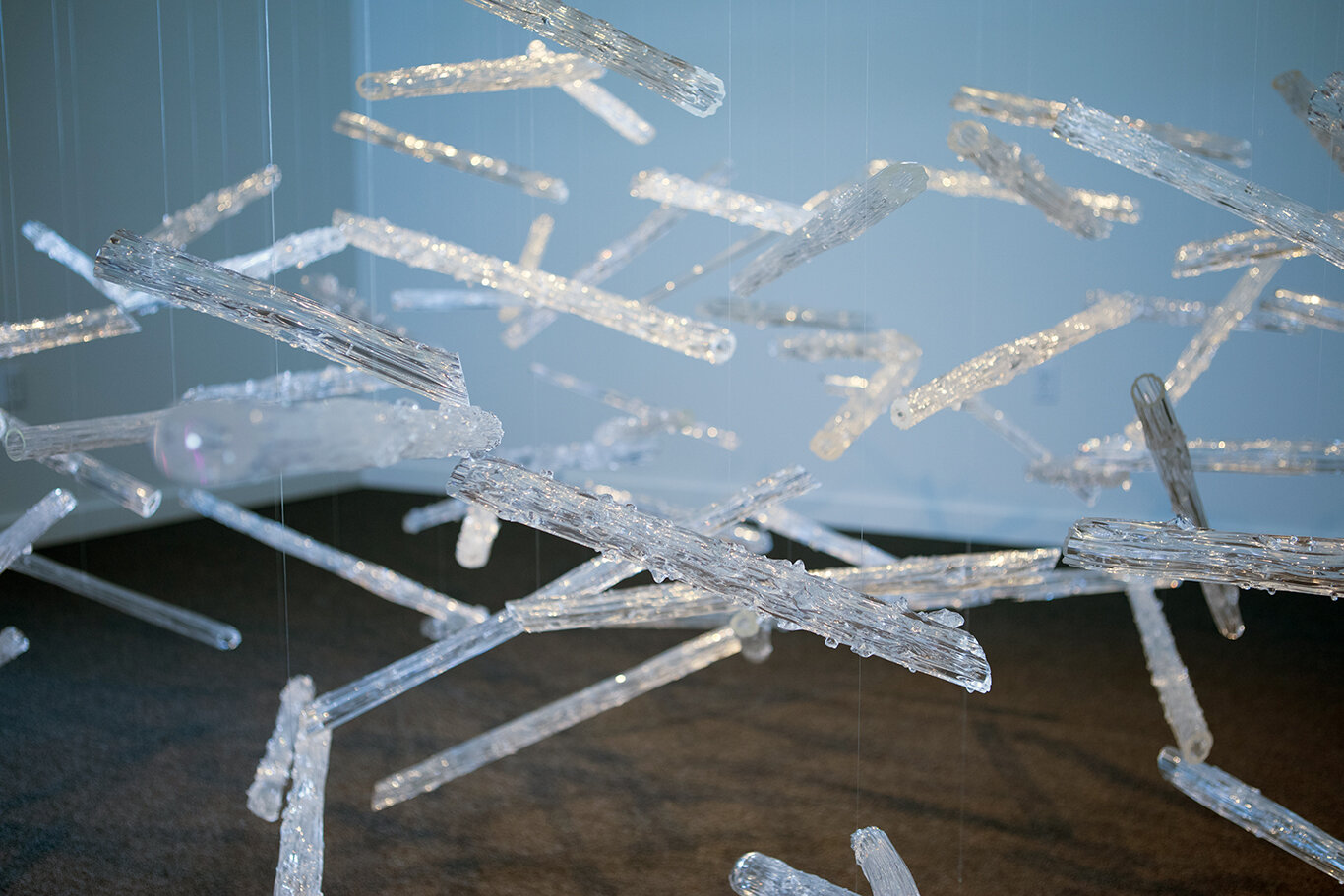
[ID: An installation of lifelike tree branches rendered in clear glass and suspended from the ceiling. The light glints off the objects, revealing the texture of the bark and other surface irregularities.]
I think both of us have this sense of ghosts in our work, in particular [Beth’s], with the vessel forms.
Hiromi: In a sense, it’s narrative, and walking up to it and seeing it in person, it’s not just a visual effect, but it kind of triggers all the different senses of my body, whether it’s hearing or smell. It’s very thought provoking through the vessel. I also love that there are so many different ways to work with glass.
Beth: Can I say something about your sculpture? The forest, tell me the title of the installation.
Hiromi: Yes, Sleeping Forest.
Beth: I was thinking about the vessel in that work, even though those pieces are not vessels. But it made me start thinking about the tree as a vessel, and the containment of life in that particular flora, and the way that everything is gently hovering in space, and that those branches are hollow, but it’s like a vessel that’s been literally chopped or truncated or destroyed on some level. That inherent loss in that piece is really interesting to me. It is a literal moment that has passed, although some people might not know it, because I started thinking about how it was made. Because I do that sometimes. Not all the time.
Hiromi: Always, always, yes!
Beth: I thought, oh, this may have started as a vessel. I don’t know if it did, it could have also not started as a vessel, but there’s a poignancy in the loss of what appears to be, that it has been reduced to a shell that alludes to the tree as the vessel.
Hiromi: Thank you. Yeah, it’s interesting. I love to hear that. I never thought of it as a vessel but in a way, we can read it as a vessel form. I love that, how you said it, that it’s sort of a shell. It could have had water in there; it could have had veins in there.
Beth: If you think about the systems of how trees grow, biologically.
Hiromi: Yes, almost like veins or hollow tubes that feed something. I didn’t think about that in my work, but it’s really interesting to hear a good, interesting perspective. I think both of us have this sense of ghosts in our work, in particular yours, with the vessel forms.
The Sleeping Forest, where it started was — I grew up in nature. I grew up in Japan and I grew up at the bottom of the Japanese Alps. The forest is behind a field of rice. I spend a lot of time in nature, and a couple years ago, when I visited and was just going for a walk in the woods, that really sort of refreshed me and brought back all my memories of growing up. And it’s that walking into the woods, the feeling of coldness and moist in the woods in the summertime, all these parts that I experienced and sensed formed into that work, I feel sort of walking in the woods, but instead of all the tree branches on the ground, it’s sort of lifted. In a way it’s sort of creating a frozen time. So that’s where that work came from.
It’s kind of interesting, because I looked at your work, and you have a piece that has trees and a shack with the wooden parts with the guns.
Beth: Oh, yeah, that’s Aspects of (American) Life.
Hiromi: I love how you approach the trees in the work. It’s thin, instead of three-dimensional. You have this fused glass that is attached to the walls, and I thought it was very interesting. It’s like, am I looking at a shadow of the trees? Or is this the trees? And a kind of very interesting conversation that I had with the work.
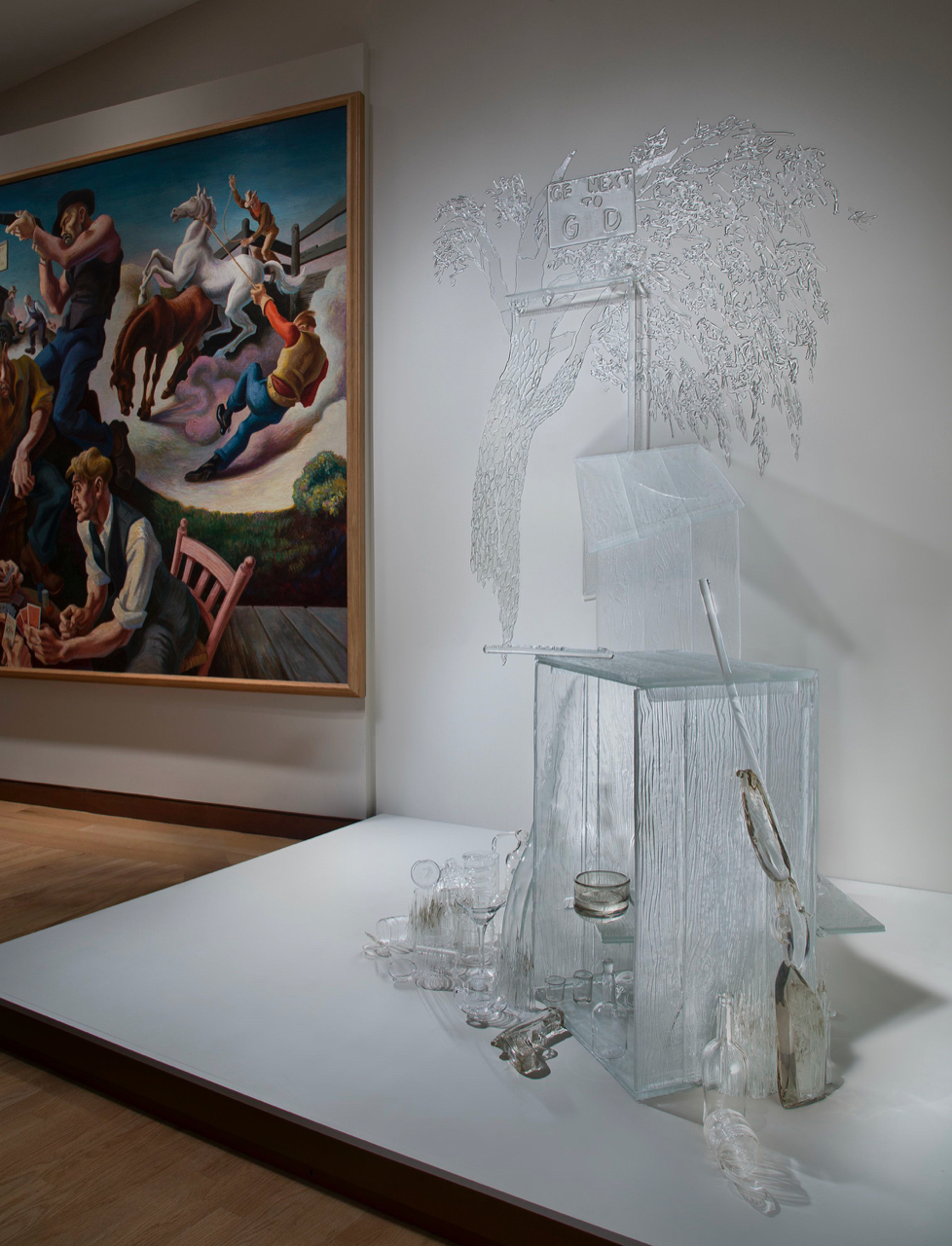
[ID: An installation made entirely of translucent glass. A tree lays flat against the wall, hovering above a three-dimensional still life on a pedestal below it: a wooden crate filled with and surrounded by glasses, bottles, and cups. A small flute is balanced precariously on top of the crate, and a rifle leans against its side; a pistol lies at the bottom, barrel aimed inwards.]
You get to a point where you’re waiting for something, and then it comes, but you didn’t think it was going to come from the left, you thought it would come from the right.
Beth: Can I ask you about your process? I’m curious about how inspiration comes to you as you’re walking in your home forest. I saw that you’re also responding to specific sites that perhaps you were invited to respond to. And I’m curious about that, how your process unfolds when you are responding specifically to sites, because I do that too in my work, and I find it to be a new experience every time. I cannot predict how the experience is going to unfold, and whether or not I will be inspired by the site that I’m in. [I’m curious how] you prep yourself to have that experience and engage in a site or a space and whether you have any control over that at all.
Hiromi: For me, I tend to pay attention to the site. I look at a space and see what works, whether it’s a gallery space, museum space, art center, any place outdoor, indoor. I look at how the light is perceived, or the history of the rooms. I research that place, and the history of the place, and that kind of helps to form and learn about the site.
At the same time, I have things in my mind that I’m thinking about over the years and it sort of comes together, like when I have an idea, but I didn’t have the right site to exhibit, but now when I see this [other] space, it will be perfect with my work. And so it’s very organic, but yes, site-specificity is important in my work.
Beth: Mine is as well. I prepare by researching the site, the history. It’s the deep mapping where you get all of the anecdotal stories, you get the geological stories, you get the cultural history, you get every aspect of information. But then, this still is not necessarily always going to lead you to a place where you have the inspiration. It does, but it’s like stepping into the unknown over and over again, which I rely on, and I appreciate that, and it spurs my practice.
But I’m fascinated about how other people cultivate that experience and arrive at a proposal or a decision. It’s like trying to herd cats. You can have three inspirations in one week and then nothing for two years. In my studio practice, you trudge through the concepts, and it’s fascinating and interesting, and then you get to a point where you’re waiting for something, and then it comes, but you didn’t think it was going to come from the left, you thought it would come from the right. That is interesting to me, and also that there’s an expectation if you’re invited as an artist, like the work that you did in the Arboretum, that you’re being invited. Did you propose the work to the Arboretum? Or did they say “would you like to do something outside in the Arboretum?,” and then you spent time there and decided what to do?
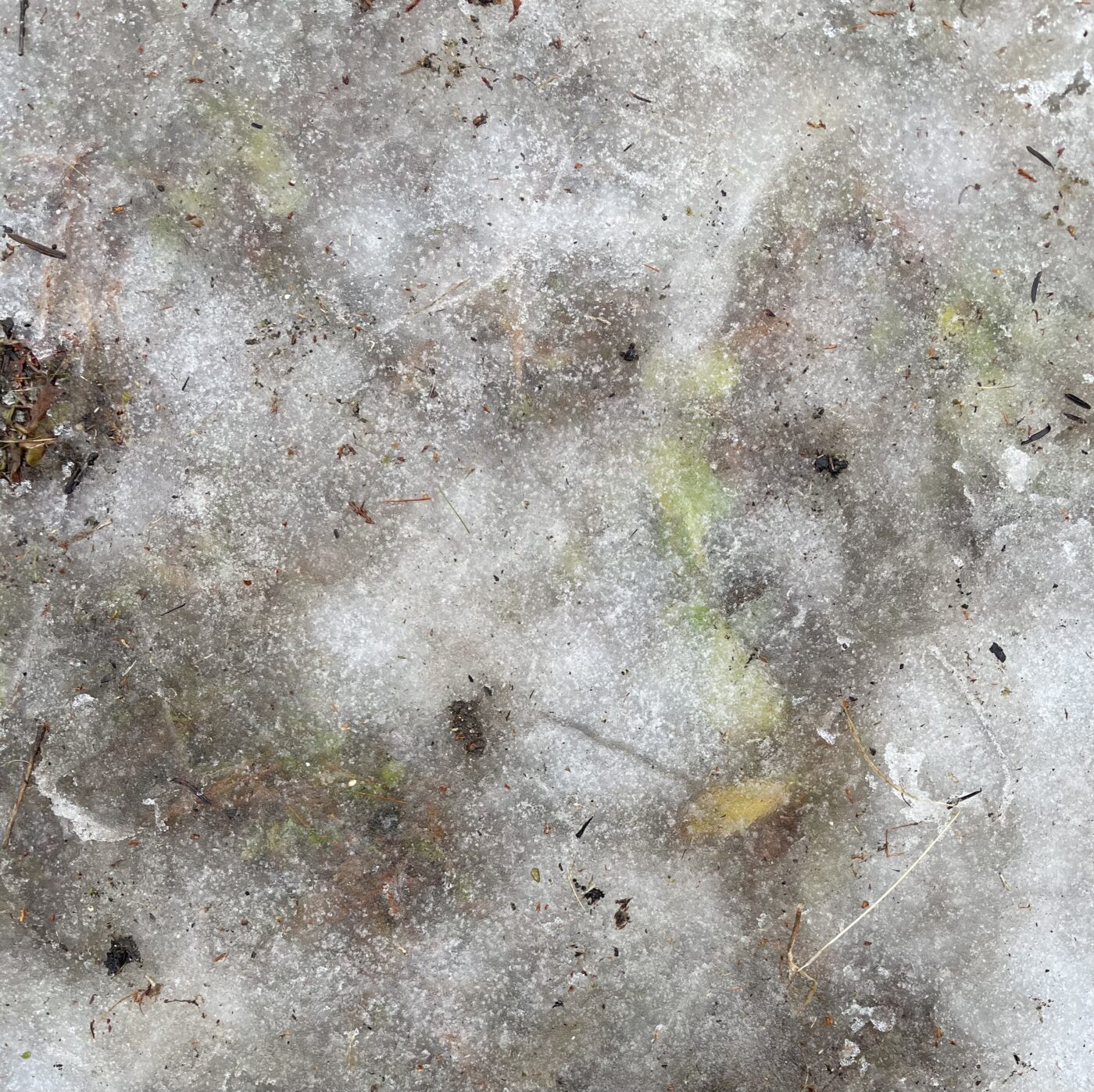
[ID: Close-up photo of ice on the ground showing various textures, swirls of translucent and cloudier patches revealing green leaves frozen under the ice with forest debris on the surface and below it.]
Vessels or glass installation are how I remember my memories. I’m always thinking of something in my head, revisiting memories or experiences, and then the opportunity or place comes and those things come together.
Hiromi: I visit a site and walk around and see what will work for this place, and sometimes I forage. For the arboretum, I wanted it to be specific to that Arboretum’s outdoors or garden so I forage the leaves, and, I take it that back into the studio, cast it in glass and bring it back to the site or create forms that reflect the surroundings of the arboretum.
It depends on the project site that I get invited to, but I feel like for a lot of my work, I visit my memories. The memory is a big part of it, revisiting traveling and getting inspired by the things that I grew up with, and its difference. I thought it was this, but now it’s different. It deforms over time, and the memory turns into some story that might not have been 100% true. The experience that I think that I experienced is translated into the work.
I also feel glass is a wonderful material to tell stories in that way, because we can talk about the memory through the colorless object. Vessels or glass installation are how I remember my memories. I’m always thinking of something in my head, revisiting memories or experiences, and then the opportunity or place comes and those things come together.
Beth: Also, It’s hard to have a static experience with the material because the light is constantly making the shape change and refract and reflect. And then it is a supercooled liquid, so it is inherently in a fluid state. That metaphor is really powerful for memory.
Hiromi: Yeah, I think so too. I’m curious, Beth, can I ask a question?
Beth: Of course, that’s all I’ve been doing! I hope you don’t mind, I didn’t ask your permission.
Hiromi: The earlier works with the vessel forms, the 16th, 17th century sort of table, filled with all these gorgeous, well-crafted, vessel forms, and it overflows, but at the same time, they’re distorted and they’re crashed. How are your thoughts transformed into that work? I’m curious how that is visualized — how your thoughts are materialized in the material, how it is translated into your work.
Beth: I start with a general premise in the work, a general question or general direction. And then the work basically unfolds in a really formal way, on some level. The compositions start with the largest volume, mass forms, and then those objects tell me what needs to happen in relation to them. So it’s a dialogue, it’s a conversation with the forms and the material. I spend a lot of time studying the composition and waiting to see what needs to happen. If it’s not clear to me right away, then I have to wait, and each installation unfolds on its own timeline. The work is always about time and history, as well as the future — past, present, and future. But the process of making the work very much mimics the content of the work. So I might have a general direction that I think something is going to go, and then it pivots and changes and is disrupted by something that is unexpected. I have a general agenda, and the agenda starts the path, then I have detours, and I have disruptions to the agenda that I’m open to, and I’m looking for. I’m constantly in dialogue with the work until the work is finished. And I know when it’s finished. As we do. I know how people ask, well, how do you know? and I say, because, you know! That’s how you know.
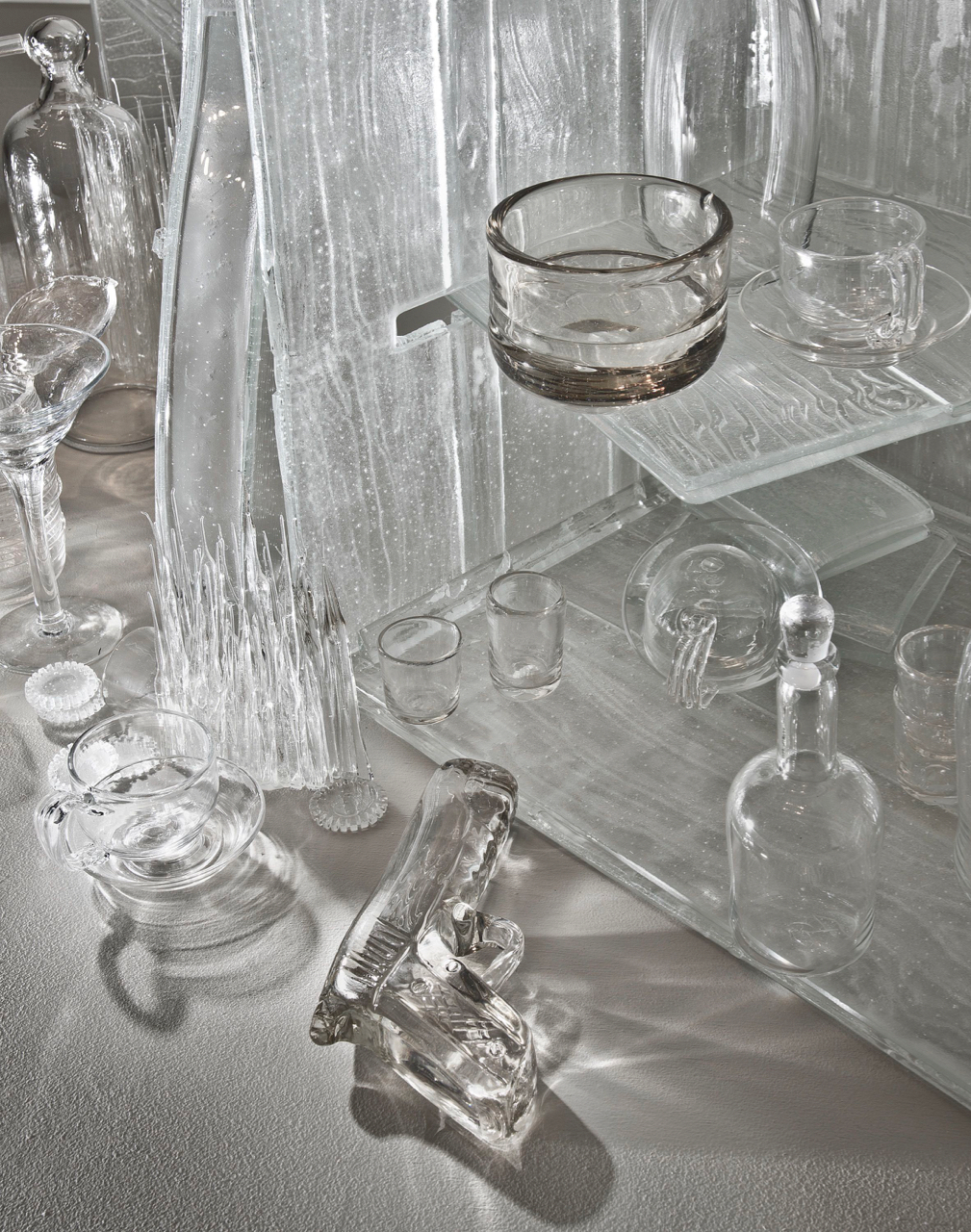
[ID: A close-up of the inside of the crate revealing haphazard shelving with small vessels balanced on it. Sharp shards of glass rest at the corner next to a cup and saucer. Light refracts through the translucent objects, leaving shimmer and shadow.]
I spend a lot of time studying the composition and waiting to see what needs to happen. If it’s not clear to me right away, then I have to wait, and each installation unfolds on its own timeline.
The very first time that something broke while I was installing it was a really important moment in the practice, where I decided to use that moment in a conceptual way and begin to understand happenstance. They’re almost like John Cage moments. You’re just opening the piano and letting all the audience talk and then shutting the piano, it’s just all of those moments become of equal value in the work, whatever that means.
I’m interested in these fusions of unintentional and intentional things, or the idea of intentionality and the idea of this fallacy of control, basically this fallacy that we’re controlling our direction, we understand our own mind. We understand 10% of our brain, that we think we know what’s going on at any given time. I’m really curious about that space of unknown, and I can go in a direction, but my life could change tomorrow, and then my direction will be different. So it’s the balance, right?
Hiromi: I feel like especially working in glass blowing, it’s just so hard to control sometimes, forms happen and sometimes, things are out of my control, and it might be the best thing to happen for the piece. I always want to control — my work doesn’t look so controlled, but I do have this thing where I want to control. But I think it’s really important for artists to let it go or to have the material speak by itself or happen in directions that are out of control.
Beth: I think that’s interesting. I was talking to someone the other day, and they were saying how they know someone that — the space between the idea and the manifestation of the idea — they have such control over their practice that they can realize [it] with no daylight between the idea and the actual finished object. They have the mastery of their practice to that extent. And I thought, why would you make it then? I would find it completely uninteresting to have that much control over everything, I would put myself at a disadvantage in order to put myself in a place of imbalance so that I could discover something more. That’s just the way my brain works though, and that’s also a form of control. We can say that as well.
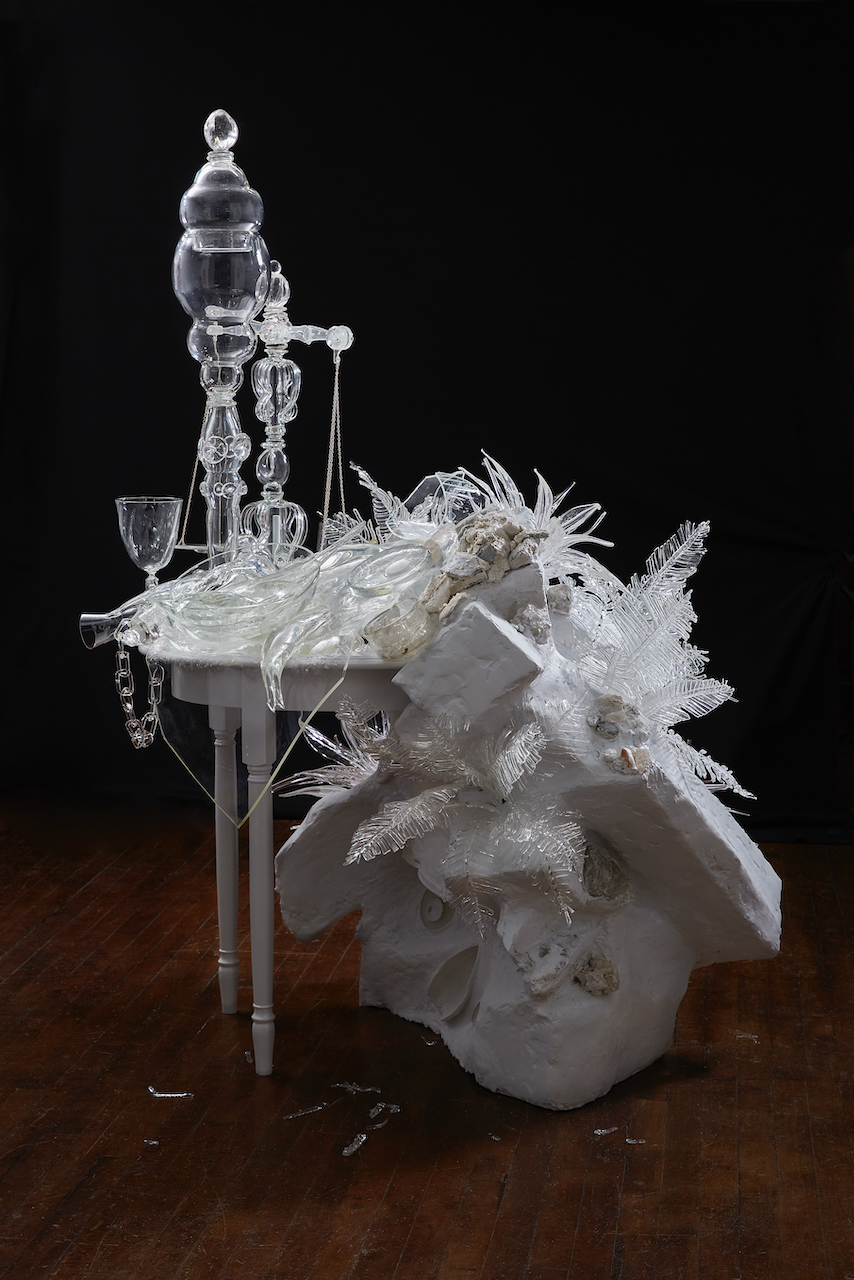
[ID: A white table covered with vessels including 18th century laboratory equipment, collapsed against a cross-section of earth covered with ferns and other prehistoric plants.]
Jessica Ferrer: I have a question for the two of you. Something someone mentioned and alluded to earlier about working with clear glass and the transparency, specifically, and we’re just curious about why both of you are interested in working with that type of glass — that clarity — what is it that compels you about it?
Hiromi: It’s the diffraction of refractive materials. I love that it can diffract and refract the light — cast the light through the glass. I love to try to tell a story with colorless materials because then it doesn’t give too much of a definition of how things should be looked at, or it kind of gives a ghostly quality, an ethereal quality. It has a weight but it doesn’t look like there is a weight in the work. There’s something about it that I really enjoy, all of that quality.
Beth, too, her work is a hot shop glass blowing to casting. And then each different stage of glass, there’s a time when the materials are fluid; there’s a time when the material gets solid, and there is that condition that I like about it, and then we can also shape it, we can form it. I love that I can work comfortably. If I use clay, I can’t see what’s inside. I can still model, but I can’t see the inside, and it’s something about glass, the fragility of it. You can’t see it, and I love that I can choose from opaque to totally clear, and it works well for me to tell my story that way. How about you, Beth?
Beth: There are several reasons why I don’t work in color. The initial reason that I abandoned color was because I really feel like colorless glass or almost colorless glass — because as we know, even the colorless glass has some tinges and shades of color, which become heightened when everything is clear. I think that the clear glass really captures the essence of an object or the idea of an object. My work is representational and narrative, and believe it or not, I consider myself somewhat of a minimalist. I reduced the color out of the material because it was not necessary. People already in their neurological interpretation are seeing green ferns and metal chalices and a candle that has just been burned out, just like when you’re reading a book, and you fill in all of the details of the space. I feel that colorless glass invites you in to have your own personal ownership over the narrative of the work. At the same time, I think it is essentially an optically-frustrating experience. Because when you have something that’s transparent, especially, you’re looking through it as you move and the light changes, what you think you see is actually not what you’re seeing. There’s a lot of optical illusion.
When I first started working in still life, I was really interested in the economic and consumerist late-stage-capitalist experience of the still life in relation to the Dutch Golden Era. It became really important for me to give the viewer something that they fundamentally could never own. You could buy it — that’s a whole other part of making art in a capitalist society — but you can’t ever fully, visually own it. It’s a constant frustration. And that, to me, really parallels this buying culture and this idea of constant growth and constant consuming, and how the moment after you’ve shopped, you are somewhat gratified, and then you’re hungry to consume again. And it’s this endless pit. So initially, the colorless clear glass really worked well for that frustration of — it’s here. It’s also beautiful, and it’s precious, it’s fragile, but it’s not really available to you, even though it’s tangible and right in front of you. Now, because I’m much more focused on mortality and the transitional and the temporal, the colorless glass just begs engagement of the ephemerality of life.
This is a historically decorative material, and so in introducing color into the material and possibly representational color, there is a danger there of it becoming just too ornamental, and just stopping the conversation. So, all of that, and I love the decorative arts. A lot of my practice is rooted in the study and understanding of the decorative arts and material culture, but I am not working decoratively with a historically decorative art material. And one of the ways that I abandon that is through the use of color, and the other way that I abandon that is through the control of the material in a traditional way.

[ID: An installation of colorful neon tubes hung in a dark interior space filled with potted plants of various sizes and textures — some placed on the floor; some hung from the ceiling. The lights create intricate shadows on the walls.]
I love to try to tell a story with colorless materials because then it doesn’t give too much of a definition of how things should be looked at, or it kind of gives a ghostly quality, an ethereal quality.
Hiromi: That’s beautiful, Beth!
Beth: I think that’s it.
Hiromi: Yeah, it leaves a space for the viewer to add their story, leaves it up to them how they wonder about the work and why the artist makes. Particularly, introducing color in the work has to be very intentional otherwise, there is too much visual weight.
Beth: I think there’s some amazing work in color. But I think I have to have a reason. I work in black glass a lot. Or occasionally, maybe not a lot. And some right now I’m making a piece that has some white glass in it as well. But there are very specific reasons for the introduction of that color, and it’s symbolic, or it’s a formal way of suggesting focal points to the viewer.
Hiromi: Yeah, I totally get it and understand. But do you like color? I end up always being clear. I edit it, edit it, edit it, edit it — my work — and it turns it into all clear, but I love the transparency or the transparent colored glass, it’s beautiful!
Beth: Gorgeous, right?
Hiromi: I have so much color in my studio. Introducing color is a whole other game.
Beth: Actually a lot of the art that I live with, that I’ve traded for, it’s all color. It’s super-saturated color. I’m not anti-color in any stretch.
Hiromi: Yeah, me too. I love the color, but I just don’t know how to use it right, maybe.
Beth: I think you do, though — your work really uses color effectively, Hiromi.
Hiromi: I use neon light as a material. I don’t do much neon text, but I love how the light passes through the transparent materials. Growing up on a mountain, I never saw a sunset go down to horizon lines or ocean. So when we have a sunset, the sun goes down behind the mountain, it’s always kind of blue. I never had this spectrum of color in the sky. That’s how I grew up.
Now I live in Southern California and just the color of the sky — I’m always amazed by the spectrum colors or light that are produced in a sunset. It’s almost like bathing into the light. I like using a neon light because I can control that light, that color in the sunset. In real life, we can’t capture it; we can’t hold on to it, but with the neon lights I’m able to mix two neon colors. Having two, three different colors of neon tube creates a third color when I cast onto glass, or when I cast on to the frosted glass, and I love that quality. But that’s how I use color.
Beth: Color really impacts me on an emotional level. I’m thinking about Dan Flavin’s work, and even James Turrell’s work, which brings us back to this conversation about light, and how important light is to the practice.
When you’re using this material, you are sculpting with light most of the time. Sometimes I can’t fully see the piece until it’s on the site with the light hitting it in the way that I had anticipated. I’m working towards the potential of what’s going to happen with the light in the specific space.
Hiromi: That makes me think about the history of stained glass, how you’re going to the cathedrals or church and the light comes through the buildings or comes through the windows. I feel that glass is a really important part of our daily life, and also there’s something magical about it. It’s magical. Light and glass is magical.

[ID: A woman with light skin and shoulder-length salt-and-pepper hair poses in front of her artwork with a gentle smile.]
Beth Lipman
She // Her // Hers
Sheboygan Falls, WI
Beth Lipman has exhibited her work internationally at such institutions as the Ringling Museum of Art (FL), ICA/MECA (ME), RISD Museum (RI), Milwaukee Art Museum (WI), Gustavsbergs Konsthall (Sweden), and the Renwick Gallery of the Smithsonian American Art Museum (DC). Lipman’s work has been acquired by numerous museums including the North Carolina Museum of Art, Brooklyn Museum of Art (NY), Kemper Museum for Contemporary Art (MO), Smithsonian American Art Museum (DC), Jewish Museum (NY), Norton Museum of Art, (FL), and the Corning Museum of Glass (NY). Recent works include Living History, a large scale site-specific commission for the Wichita Art Museum (KS) that investigates the nature of time and place and Belonging(s), a sculptural response to the life of Abigail Levy Franks for the Crystal Bridges Museum of American Art (AR). ReGift, a site specific installation investigating the life of Florence Scott Libbey, will be on view at the Toledo Museum of Art in the summer of 2023.
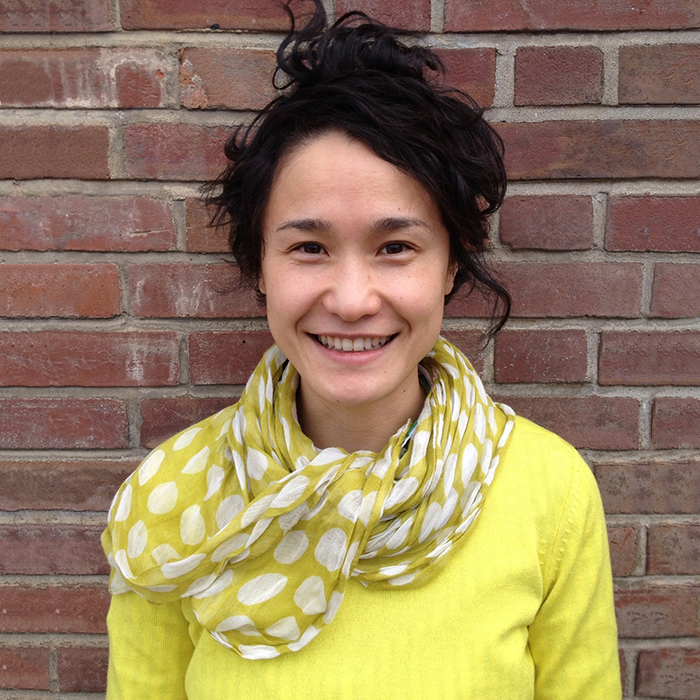
[ID: Hiromi, a woman with dark, wavy hair tied on top of her head, stands smiling against a brick wall. She is wearing a yellow sweater and a matching scarf.]
Hiromi Takizawa
She // Her // Hers
Santa Ana, CA
Hiromi Takizawa was born and raised in Nagano, Japan, and lives in southern California. Curiosity, experimentation, narrative, and materiality encapsulate Takizawa’s artistic practice. She has exhibited nationally and internationally, including solo exhibitions at Heller Gallery and Urban Glass in New York, Orange County Museum of Art, and group exhibitions at the Museum of American Glass in New Jersey, Houston Center of Contemporary Craft, and S12 Gallery in Norway. She is an Associate Professor in Glass at California State University, Fullerton. Takizawa has taught workshops at Pilchuck Glass School, Haystack Mountain of School of Crafts, and Toyama Glass Institute in Japan.
